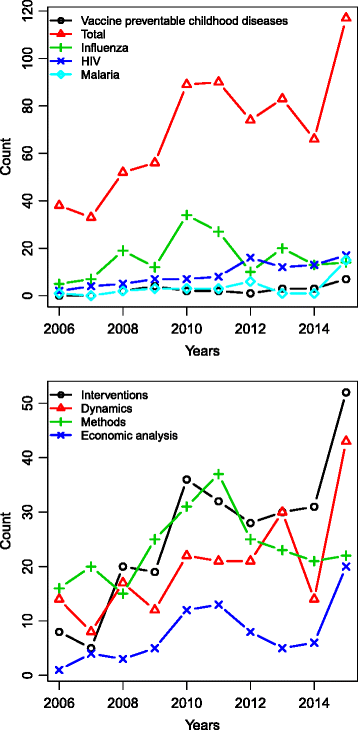Lessons from a decade of individual-based models for infectious disease transmission: a systematic review (2006-2015)
- PMID: 28893198
- PMCID: PMC5594572
- DOI: 10.1186/s12879-017-2699-8
Lessons from a decade of individual-based models for infectious disease transmission: a systematic review (2006-2015)
Abstract
Background: Individual-based models (IBMs) are useful to simulate events subject to stochasticity and/or heterogeneity, and have become well established to model the potential (re)emergence of pathogens (e.g., pandemic influenza, bioterrorism). Individual heterogeneity at the host and pathogen level is increasingly documented to influence transmission of endemic diseases and it is well understood that the final stages of elimination strategies for vaccine-preventable childhood diseases (e.g., polio, measles) are subject to stochasticity. Even so it appears IBMs for both these phenomena are not well established. We review a decade of IBM publications aiming to obtain insights in their advantages, pitfalls and rationale for use and to make recommendations facilitating knowledge transfer within and across disciplines.
Methods: We systematically identified publications in Web of Science and PubMed from 2006-2015 based on title/abstract/keywords screening (and full-text if necessary) to retrieve topics, modeling purposes and general specifications. We extracted detailed modeling features from papers on established vaccine-preventable childhood diseases based on full-text screening.
Results: We identified 698 papers, which applied an IBM for infectious disease transmission, and listed these in a reference database, describing their general characteristics. The diversity of disease-topics and overall publication frequency have increased over time (38 to 115 annual publications from 2006 to 2015). The inclusion of intervention strategies (8 to 52) and economic consequences (1 to 20) are increasing, to the detriment of purely theoretical explorations. Unfortunately, terminology used to describe IBMs is inconsistent and ambiguous. We retrieved 24 studies on a vaccine-preventable childhood disease (covering 7 different diseases), with publication frequency increasing from the first such study published in 2008. IBMs have been useful to explore heterogeneous between- and within-host interactions, but combined applications are still sparse. The amount of missing information on model characteristics and study design is remarkable.
Conclusions: IBMs are suited to combine heterogeneous within- and between-host interactions, which offers many opportunities, especially to analyze targeted interventions for endemic infections. We advocate the exchange of (open-source) platforms and stress the need for consistent "branding". Using (existing) conventions and reporting protocols would stimulate cross-fertilization between research groups and fields, and ultimately policy making in decades to come.
Keywords: Agent-based; Dynamics; Emerging diseases; Endemic diseases; Individual-based; Mathematical epidemiology; Modeling; Networks; ODD protocol; Transmission.
Conflict of interest statement
Ethics approval and consent to participate
“Not applicable”.
Consent for publication
“Not applicable”.
Competing interests
The authors declare that they have no competing interests.
Publisher’s Note
Springer Nature remains neutral with regard to jurisdictional claims in published maps and institutional affiliations.
Figures
References
-
- Mossong J, Hens N, Jit M, Beutels P, Auranen K, Mikolajczyk R, Massari M, Salmaso S, Tomba GS, Wallinga J, Heijne J, Sadkowska-Todys M, Rosinska M, Edmunds WJ. Social contacts and mixing patterns relevant to the spread of infectious diseases. PLoS Med. 2008;5(3):74. doi: 10.1371/journal.pmed.0050074. - DOI - PMC - PubMed
Publication types
MeSH terms
Substances
LinkOut - more resources
Full Text Sources
Other Literature Sources


